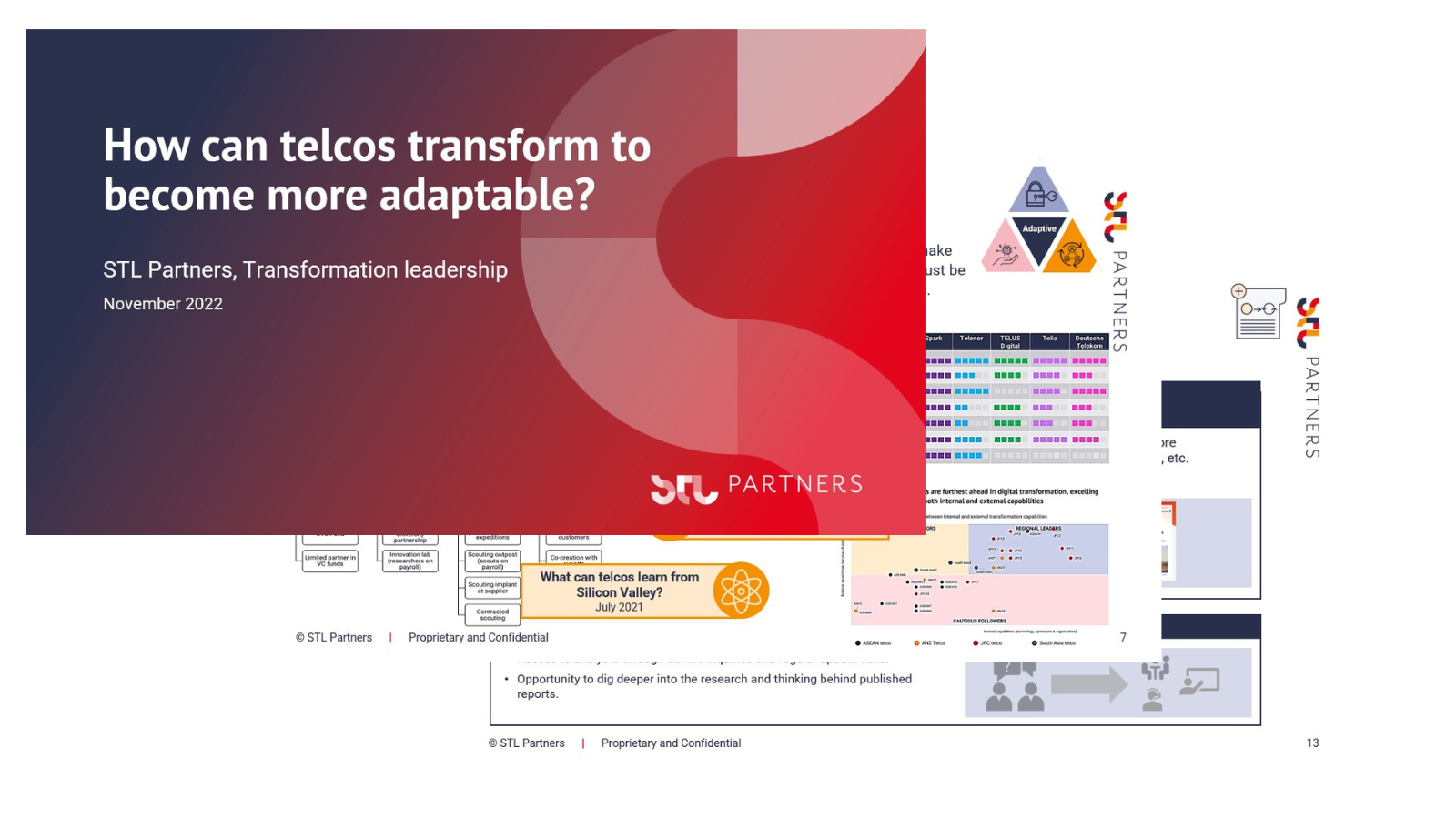
RIC, xApps, rApps: A Comprehensive Guide to the Key Players
As the radio access network continues to evolve towards more open architecture, opportunities for innovation in the Open RAN space have proliferated. One of the central components within Open RAN architecture is the RAN Intelligent Controller (RIC), which provides an open hosting platform for innovative xApps and rApps. We highlight 12 key players in this space.
What is the RIC and where do xApps and rApps fit in?
As the Radio Access Network continues to evolve towards more open architecture, opportunities for innovation in the Open RAN space have proliferated. One of the central components within Open RAN architecture is the RAN Intelligent Controller (RIC), which provides an open hosting platform and is responsible for controlling and optimising the RAN functions.
The RIC incorporates AI/ML into its decision-making functionalities and comes in two forms: near real time and non-real time, which can be adapted to specific latency or control loop requirements. Near real-time RIC can control the other RAN elements, including CUs and DUs, and perform network optimisation actions that can take place between 10 milliseconds to one second. Non-real-time RIC, a concept developed by the O-RAN alliance, incorporates intelligence into the system design to perform network management tasks and works for control loops of over 1 second. Essentially, Non-RT RIC provides the Near-RT RIC with network and subscriber data, alongside AI based recommendations, whilst the latter provides real-time optimisation for mobility management. Furthermore, the non-RT RIC can provide high levels of quality assurance, right down to the device level, by monitoring QoE results that have been achieved.
As a software hosting platform, the RIC can run applications developed by third party specialist software providers. These applications are known as “xApps” and “rApps”, and act as key enablers (which run on near-real time RIC software platforms) or (which run on non-real time RIC software platforms), and act as key enablers for innovation in the Open RAN ecosystem.
This article looks at some of the key players within the RIC, XApp and rApp space.
Accelleran
Belgian start-up Accelleran has released their own cloud-native Open RAN software, known as dRAX. It provides the near-time RIC, SMO (Service Management & Orchestrator), 4G/5G CU (Central Unit), xNodeB software and a host of different xApps. Its dRAX-RIC near real-time platform enables the roll-out of smart apps for managing and optimising the RAN. It has been developed as an open platform to allow third-party app integration and incorporates the benefits of AI and Big Data to enable near-real time control functions. Its own library of xApps is also available for automated installation, as well as other third party xApps that it supports.
Its xApp offerings include:
- dRAX Dashboard
- Near zero-touch provisioning
- Automated Neighbour Manager
- Smart Handover
- Automated PCI Allocation
Airhop
Airhop is a cloud native radio access network software technology company. It has joined the Open Networking Foundation (ONF), an organisation that launched the SD-RAN project in 2020 to develop elements to be used in disaggregated RAN rollouts. Since joining the ONF, Airhop has been developing a near-RT RIC and set of xApps for controlling the RAN. In April 2021, alongside Facebook and the Telecom Infra Project (TIP), the trio demonstrated the first multi-vendor RAN automation by integrating the SD-RAN RIC from ONF with Airhop’s xApps.
Altiostar
Another key player in the RIC space is Altiostar, a provider of open vRAN technology. Altiostar has already developed its own cloud-native microservice-based solutions, which include the gNB virtual Centralised Unit (vCU), gNB virtual Distributed Unit (vDU), virtual EMA and 3rd party O-RAN compliant Radio Units and antennas. All these units interface with COTS hardware platforms using a virtualised platform. More recently, Altiostar has been developing its own near-RT RIC platform as well as its own xApps. It also plans to support 3rd party RICs, which can enable functions including traffic steering, radio channel resource optimisation and resource allocation strategies, as well as slice QoS monitoring and enforcement.
Cohere Technologies and VMware
Cohere Technologies is a Californian vendor with a new network enhancement proposition, developed in partnership with VMware by leveraging the latter’s RIC. Cohere’s offering utilises predictive technology for beamforming to deliver performance improvements to wireless broadband connections and can be applied across 4G, 5G and Wi-Fi networks. It has enhanced existing channel estimation to include channel prediction, and its scheduler software can be integrated into existing RAN systems on x86 based platforms at base stations, or run on any processor. Alternatively, it can be run as an xApp within cloud RAN architecture on the VMware RIC.
The partnership between Cohere and VMware will enable mobile network operators to make full use of all spectrum assets to deliver on next generation AR/VR streaming, immersive gaming and 4K videos. Cohere’s Spectrum Multiplier xApp improves spectrum by up to 2X for 4G or 5G, and thanks to VMware’s RIC residing in the Telco Cloud, the need for costly and energy-consuming hardware within a mobile base station is drastically reduced. In the year ahead, the partners are working with Vodafone to demonstrate how a platform built on O-RAN principles can boost capacity further by enabling multi-user MIMO for 5G mobile networks.
Juniper Networks
In partnership with Turk Telekom’s Netsia subsidiary, Juniper Networks has entered the Open RAN space with its newly developed RIC. Juniper Networks has licensed the RIC technology from Netsia and is using its own kit to develop the code and ensure it works with Turk Telecom’s Open RAN integration. As part of this partnership, Netsia will transfer its RIC technology, related source code, patents, rights and technical domain experts to Juniper to support the integration into the latter’s product portfolio. Its RIC comes in both near-RT and non-RT forms, with the ability to host both xApps and rApps from any third-party providers.
Turk Telekom also plans to leverage this RIC and Juniper’s broader portfolio as part of its Open RAN and 5G deployment and is expected to have an initial proof-of-concept project in late 2021.
Mavenir
In partnership with Airtel, Mavenir demonstrated its O-RAN RIC at the Global O-RAN Alliance Plugfest in India towards the end of 2020. The Global Plugfest highlighted the latest developments in the O-RAN ecosystem and was an opportunity for participants to test the interoperability of their O-RAN defined solutions. Mavenir and Airtel’s RIC incorporates advanced ML for network performance enhancement through the ingestion of a demonstration RAN’s performance metrics and configuration data. During the event the partners successfully demonstrated the ability to optimise configuration parameters and improve on pre-defined KPIs.
Nokia
Nokia announced the launch of its Service Enablement Platform (SEP) in March 2021. Its commercial solution will deliver network programmability and introduce AI/ML into the Open RAN ecosystem. Nokia’s SEP launched with a selection of xApps, including Advanced Traffic Steering and Anomaly Detection. Nokia’s SEP platform is unique to the other providers in the list given that it is the first to combine near-RT and MEC capabilities into one platform, which may be configured to specific CSP or enterprise requirements.
Nokia trialled a number of xApps in partnership with AT&T, with Nokia hosting these applications at the edge of AT&T’s 5G mmWave network on an Akraino-based Open Cloud Platform. The xApps were designed to enhance spectrum efficiency, demonstrate other use-case based customisation and rapid feature onboarding in the RAN. The partners are planning to release the RIC into open source, allowing third parties to help develop the code further.
Parallel Wireless
Parallel Wireless have also developed its own OpenRAN Controller to enable Open RAN solutions. Its controller is the first to provide an “all G” RAN, offering virtualised 2G BSC, 3G RNC, 4G eNB, X2/S1 Gateway in any combination. As a 5G native platform, it can also provide a straightforward migration pathway to 5G. Further, Parallel Wireless provides both near-RT and non-RT controllers. The near-RT RIC provides complete RAN orchestration, with self-configuration, self-optimisation and self-healing. The non-RT RIC provides offers configuration, device, fault, performance and lifecycle management for all elements within the network. The software also provides a layer of intelligence that can be applied across the network.
Sterlite Technologies (STL) and ASOCS
At the Global O-RAN Alliance Plugfest hosted in India in 2020, hosted by Bharti Airtel, STL and ASOCS showcased the fruits of the partnership: its RAN Intelligent Controller. The demonstration highlighted the near-RT RIC’s mobility load balancing capabilities on the O-RAN E2 interface, with future prospects to handle and balance increasing network loads through software defined networks. Speaking at the event, CTO Rajesh Gangadhar commented “The demos delivered to the O-RAN community truly demonstrates the different possible scenarios of 4G/5G networks could be deployed with open and disaggregated RAN and will no doubt help operators expedite commercial 5G enterprise and macro network rollouts”.
Viavi
In 2020, in partnership with AT&T, Samsung and Nokia, Viavi demonstrated its TeraVM O-RAN RIC Tester at the O-RAN Alliance Plugfest. Tera VM is an AI-Assisted, virtualised tool enabling operators to test their RIC to ensure they are able to optimise RAN resources, reduce signalling and improve capacity. Developers can use this tool to test that the RIC is working as it should be. It works by emulating the RAN to the RIC under test, which then receives the output from the RIC to modify in line with the intended changes to the RIC. The ultimate aim is to make it make it easy to test whether changes improve the RAN efficiency.
Network APIs: Unlocking new value in the telco cloud
Network APIs may offer an answer to the question of how to monetise recent and upcoming telco cloud deployments. Virtualised networks upgrade APIs and enhance the value they offer to developers and customers. To unlock their potential, telcos should focus on optimising their commercial models.
Telco Network Energy Efficiency: The Role of the RAN in Future Energy Consumption
With sustainability increasingly front of mind for stakeholders, operators are looking to the RAN for energy saving solutions to support their journey to net zero. This article details both the need for such solutions and what is on offer in the current marketplace.
Network Futures overview pack
Our Network Futures Service provides a roadmap for new network ownership, regulation and partnership models, and insights. into new technologies, industry dynamics and new players.




